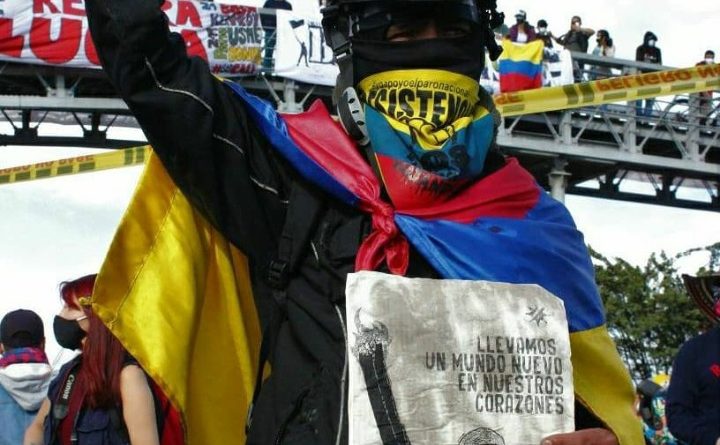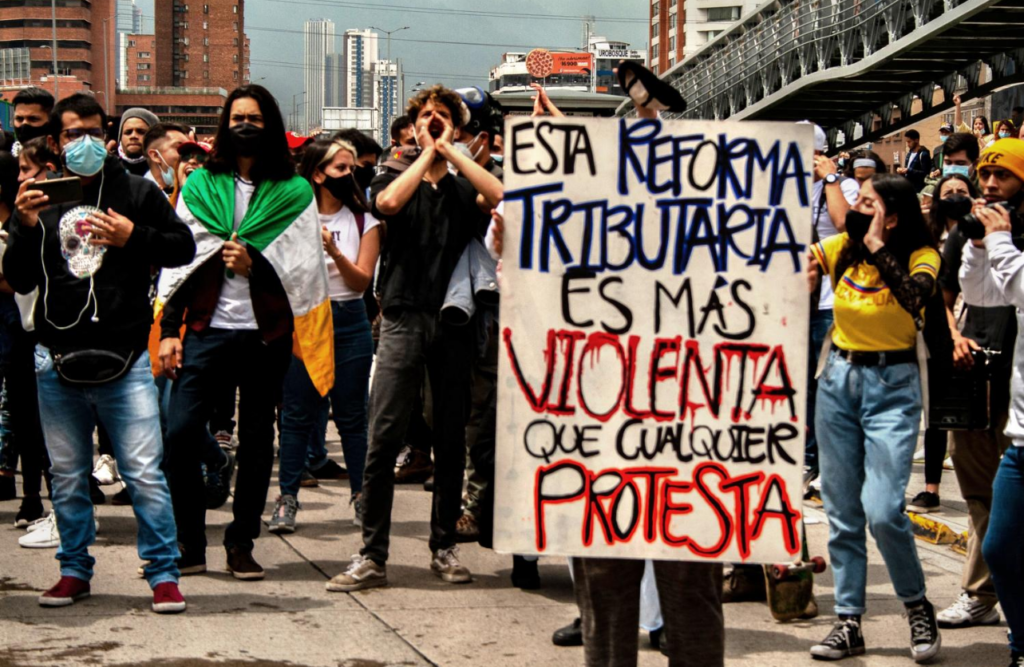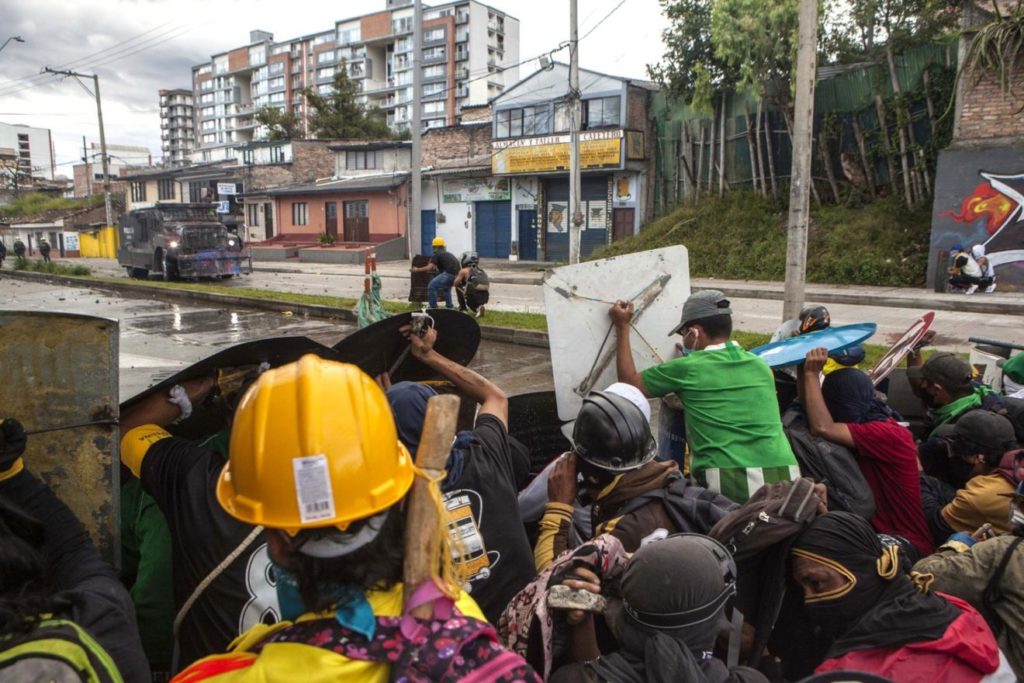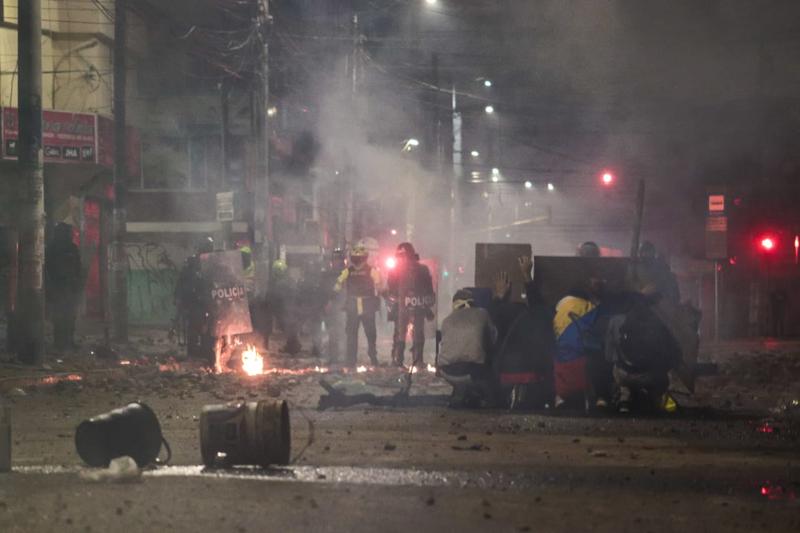My thanks to P for bringing this interview to my attention.
Deepl translation of this interview with Grupo Libertario Vía Libre, from Bogotá:
“Criticism of the tax reform soon included other historical social demands of various collectives in Colombia”
 “We carry a new world in our hearts”
“We carry a new world in our hearts”
June 2021
The Grupo Libertario Vía Libre is a political organisation based in Bogotá, Colombia, founded on 20 June 2010. It inherits and is part of the tradition of social and organised anarchism worldwide and of the rich and diverse history of popular struggles in Colombia, Latin America and the world.
Currently, Vía Libre is active in different social fronts and seeks to bring together anarchists under common principles and a common political programme*. Via Libre develops its political practice in sectors such as students, women, sexual dissidence, peasants and urban workers. It also projects, promotes and participates in processes linked to popular education, territorial work, anti-speciesism and environmentalism, human rights, urban art and solidarity with other struggles at local and global level.
The first mobilisations, which began on 28 April, demanded the elimination of the draft Sustainable Solidarity Law. What does this law consist of and why has it been the trigger for massive protests?
The bill presented by the government of Iván Duque of the Democratic Centre was a neoliberal economic adjustment policy in the midst of the deep economic crisis unleashed by the pandemic, which meant a decrease in GDP by 2020 of -6.8%. This project, the third bosses’ tax reform presented by the Uribista administration in three years in office, sought to reduce the fiscal deficit calculated at 35 trillion Colombian pesos, by increasing direct and indirect taxes on the working population, while maintaining the general model of large tax exemptions for companies and the bourgeoisie.
The background to this bosses’ programme was the historic public health crisis and an economic crisis similar to 1929, which has increased inequality, poverty reaching 42% of the population, unemployment hitting 15% and precarious work leading to 88% of workers earning less than two minimum wages.
The bill was soon widely rejected by the working population, and the movement of 28 April, the seventh general strike movement against the government, succeeded in catalysing, partly through significant agitation work, the strong rejection of the government. Finally, under pressure from the street, the government found itself in a minority in parliament, betrayed by the leadership of its own party, and on 4 May it was forced to withdraw the bill and accept the resignation of Finance Minister Alberto Carrasquilla, one of the strongmen of the ruling Uribista, conservative and evangelical coalition, on the 5th of the same month.
 “This tax reform is more violent than any protest” – banner against Iván Duque’s tax reform, at the National Strike on 28 April 2021, in Bogotá.
“This tax reform is more violent than any protest” – banner against Iván Duque’s tax reform, at the National Strike on 28 April 2021, in Bogotá.
The origin of the protest was surpassed from the very beginning, with demands for an end to femicide, opposition to mega-mining and fracking projects, respect for indigenous peoples and student demands. What are the demands of the movement?
The truth is that the initial general demand for the rejection of the tax reform, was articulated early on with a more open, diverse and disjointed set of social demands such as those you mention, in addition, for example, to the neoliberal health reform bill, which was also withdrawn on 19 May. Furthermore, the high levels of police and para-police repression deployed against the movement soon brought to the centre the demands of the victims of police violence and the rejection of state and para-state violence, which are linked to historical demands such as the dismantling of the National Police’s Mobile Anti-Riot Squad (ESMAD) and an end to the assassination of social leaders.
In parallel, during the national days of protest in November-December 2019, the National Strike Committee, a bureaucratic body mainly driven by the majority unions, drew up a programme that was later expanded during the crisis of 2020 and the protests of that year. Although it has been argued that the mobilisation is based on this programme, which may contain important demands, this is inaccurate, as it is generally unknown to the majority of demonstrators and its elaboration and sharing was absolutely limited.
On the other hand, the previous struggle of the state teachers against the return to classroom teaching without sanitary conditions, of the university students for free tuition, of the state workers for a national state list of demands, of the indigenous, black and peasant communities for agrarian support policies have been added at this juncture.
Is this rejection of the government being capitalised on by Gustavo Petro’s opposition, or are the protests far removed from political parties?
There is great opposition to the Duque government and since the national strike of 21 November 2019 the slogan “Duque out!” has been widespread. However, the demand to get the government out has not managed to become sufficiently established and this is an element that is not included in the more concrete demands, at least in the immediate future.
On the one hand, there are the centrist sectors of the so-called Coalition of Hope, which have unsuccessfully sought to represent a movement that had been condemned and repressed by local governments. On the other side is the social democratic leadership of Gustavo Petro and the electoral movement Colombia Humana. They are popular among many protesters, both among trade union and social organisations, and among popular youth who are making their first political experience. However, although they have a certain media role, they have not played a relevant role in the organisation and development of the protest. Petro himself, who has been called the “biggest anarchist in the country” by pro-Uribe senators, only participated in one mobilisation after 20 days of protest, and his supporters are seeking an electoral channelling of this dynamic in view of the 2022 presidential elections.
Left-wing political parties have played a role at this juncture, especially in the context of trade union or student activity, but they have not led such an explosive and inorganic movement. Although it is against a background of many years of community activity and organisation, in many local activities the football clubs or groups of friends in the neighbourhoods have played a more important role than the traditional social organisations.
We see images and read stories of neighbourhoods that have risen up, are highly mobilised and have even expelled police forces. How are these places organising themselves? Have new structures been created to enable neighbourhood self-organisation or did they already exist before?
These situations are very interesting, but so far they are short-lived and fragmentary. There is a clear element of rejection of the police by important sectors of popular youth, expressed in the attacks on police facilities such as the Comandos de Atención Inmediata (CAI), taking up elements of the revolt against police brutality of 9 and 10 September 2020, following the cruel murder of Javier Ordoñez, a movement whose repression resulted in at least 13 deaths.
The level of mobilisation varies greatly at regional and local level, with the situation in the department of Valle del Cauca in Cali or Yumbo being particularly notable for the so-called points of resistance with more or less continuous street blockades. In the second week of the mobilisation, sectors of transport workers such as lorry and taxi drivers also carried out road blockades with their own more corporate demands.
In general, the idea of spontaneous activity and the practice of permanent mobilisation prevails, although the forms of self-organisation are still weak. Compared to the 2019 protest, where local popular assemblies were developed in embryonic form and later dissolved, the levels of community self-organisation seem weaker at this juncture, although experiences in this sense have been developed in Cali, some popular neighbourhoods and public universities.
In places like Cali, we have seen indigenous peoples coming to the city to join the marches. What are their demands and how do they participate in the protests?
Indigenous peoples have had a diverse participation in the current situation and have generally received a racist response from the business press and conservative sectors that portray them as uncivilised. On the one hand, sectors of the Misak people organised in the Indigenous Authorities of the South West (AISO) have developed symbolic actions focused on the debate on historical memory, such as the toppling of statues of colonial conquerors such as Sebastián de Belalcázar in Cali or Gonzalo Jiménez de Quezada in Bogotá. On the other hand, indigenous peoples from the Amazon region, the Caribbean and the centre of the country have participated in various mobilisations in the major national capitals and have led their own protest activities.
At the same time, a mainly Nasa indigenous sector in the department of Cauca, organised in the Regional Indigenous Council of Cauca (CRIC), has been carrying out a struggle since mid-April for the recovery of lands in the hands of landowners and companies, which it has called the ‘Minga hacia adentro’ (Minga inwards). Since the beginning of May, the Minga inwards has been branching outwards, and they began to blockade the Pan-American Highway together with peasant organisations and black communities, partly because of national demands, but also to demand the fulfilment of previous agreements between the national government and the rural sectors. During this same period, a group from the CRIC travelled to Cali, as it had done in the second half of 2020, to participate in the protest and eventually in the blockades, where they suffered strong and racist police and para-police repression, as well as attempted massacres.

The indigenous guard of Cauca in the mobilisations of May 2021.
Although the protests have a very broad ideological framework, we see a strong participation of anarchist collectives. What role is anarchism playing in the mobilisations?
Yes, there is an anarchist presence in the social outburst, although it is still very weak and marginal. While in November 2019 we achieved a momentary leadership in some popular neighbourhoods such as the Guacamayas neighbourhood in Bogotá and in the student movement of 2018 we did the same in some humanities courses in public universities, we think that now our influence is less clear.
However, for the last decade, the presence of red and black, purple and black and black flags in union, student and neighbourhood marches has become a little more common, although we often find ourselves in relative solitude. There is also the presence of chants like “rise up with those who fight” and graffiti, and the constant activity of many comrades in different social sectors and protests.
We think that the organised anarchists have the task to continue to push this popular movement with interesting libertarian elements to strengthen its anarchist elements of democratic, deliberative and direct self-organisation, to strengthen the libertarian socialist elements of the demands and political reflections and the internationalist, intersectional and revolutionary spirit and symbolism.
The Colombian security forces have a long history of repression and human rights violations. How is the government’s repression going?
The repression against protest, especially against road blockades, soon combined the “legal” elements of the use of police force with the irregular and illegal elements so characteristic of the Colombian state. Thus, on the one hand, we have the anti-riot action of the available forces, the national police and the ESMAD, applied with an extraordinarily high level of severity, which has been reinforced by the call for military aid announced by the national government since 1 May and the presence of army troops in areas such as Valle or Atlántico and in various road blockades.
On the other hand, we have the presence of unidentified civilian agents and the shots, including machine gun fire, fired at demonstrators by the police themselves in situations of unrest in the neighbourhoods of Bogotá and Cali, of which there are 133 documented cases. And then there is the action of parapolice and paramilitary forces, with shots fired at demonstrators in Cali, Pereira or Medellín from cars or buildings.
According to Indepaz records, on 20 May there were 47 deaths from police and parapolice repression. In addition, Temblores and Indepaz recorded 30 victims of ocular violence on 16 May, 1,055 irregular detentions, at least 362 injured, a total of 2,110 cases of violence by the security forces, and the Ombudsman’s Office recorded 548 reports of disappearances on 9 May. In addition, the application of illegal procedures to extend detentions, the occurrence of raids on homes without warrants, the firing of tear gas on homes, the application of cruel treatment and torture against detainees, intermittent power cuts in areas affected by the repression have been denounced.

We read countless reports of abuse and sexual violence against women. Is this a common practice among the security forces?
Yes, unfortunately it is. The State Security Forces, police and military, are overwhelmingly composed of men with macho values, the high police and military hierarchy is exclusively male, the members of these bodies live within a violent and harassing patriarchal body and their relations with civilians are also marked by all kinds of expressions of male domination.
In police repression, gender-based violence and acts against women and sexual dissidents are common, and there are repeated reports of abuse in police stations, trucks and detention units. Military activity is even worse, because terror against women is used as a weapon in the counter-insurgency struggle, as a strategy of war.
At least 16 cases of sexual violence against women demonstrators and 3 open cases of gender violence have been registered in the current situation.
Demonstrations and other signs of international solidarity are taking place outside Colombia. Do you hear this news? What can we do from abroad to support your struggle?
This news is comforting and shows us the greatness and beauty of international solidarity. Although many of these demonstrations have been called by Colombians abroad, whether students or political exiles, there has always been an important participation of people from the most diverse origins and geographies in support of the social struggle in the region and denouncing government repression.
The international work of disseminating information, denouncing repression, discussing the national situation in different areas, symbolic and logistical accompaniment of victims, financial support for campaigns to buy implements and food, pressure on the media and politicians to clarify their position on this serious situation, as well as actions to put pressure on the Colombian state in embassies and delegations, are very valuable.
Our situation is difficult, but broader, continuous and sustained internationalist efforts are vital because the situation of the popular struggles in Myanmar, Kurdistan, Western Sahara or Palestine is also dramatic. However, it is also important that the social struggle in Colombia feeds the various local popular struggles, and that the best of our experience of mobilisation allows us to strengthen the social and popular organisations and movements of the world, just as the indignados and the 15 May movement did a decade ago.
Libertarian Group Via Libre
https://grupovialibre.org/
* SF note: “A common political programme” is not my notion of the way forward. I have made my position clear about programmes here.
Leave a Reply